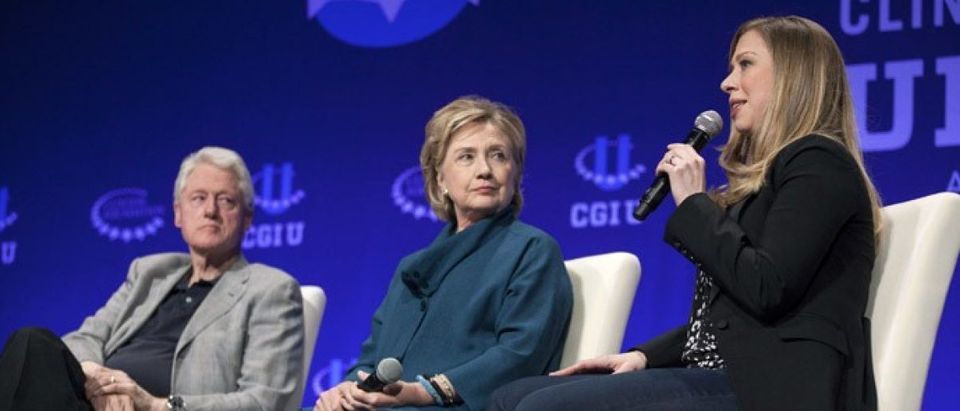Just before an Iranian-American businessman was freed from jail in Iran in Oct. 2010, his son met with Bill Clinton and also made the first of what would become more than $1 million in donations to the Clinton Foundation.
Sources tell The Daily Caller that Nima Taghavi, who owns businesses in California, grew impatient in 2010 with negotiations to secure his father Reza’s release from an Iranian prison, and so he turned to the former president for help.
To arrange the meeting with Clinton, Taghavi first contacted Doug Band, who worked as Clinton’s “body man,” has counseled the Clinton Foundation, and co-founded Teneo Holdings, a consulting group that Clinton advised.
The elder Taghavi was detained in May 2008 during a trip to the Islamic regime and accused of financing terrorist activity after he gave $200 to an Iranian man who turned out to have ties to a terrorist group suspected in a mosque bombing in Shiraz. Taghavi, who was 69 years old when arrested, said he was only doing a favor for his friend in the U.S. and had no idea that the man who would receive the money was involved in terrorism.
Insisting on his father’s innocence, Nima Taghavi and his family engaged in a multi-front lobbying effort to help his dad. He hired Pierre-Richard Prosper, an attorney at the firm Arent Fox, to negotiate directly with the Iranians.
Prosper, who served as ambassador-at-large for War Crimes Issues during the George W. Bush administration, met five times with the Iranians during his negotiations for Taghavi.
After negotiations conducted in 2009 and 2010 failed to produce results, Nima Taghavi and the family looked at different strategies to help free Reza. Federal lobbying records show that in 2010 Taghavi paid $12,000 to Profile Strategy Group to lobby Congress and the State Department to help with his father’s release.
And then there was the meeting with Clinton.
Taghavi met with the former president in hopes that he would serve as special envoy to Iran, sources told TheDC. And through his personal charity, the Nima Taghavi Foundation, the businessman gave a $5,000 donation to the Clinton Foundation in 2010. He would go on to give more than $1 million over the next several years.
The timing of the meeting and the first round of donations raises two questions: whether Clinton promised to help Taghavi in exchange for contributions to his family’s organization and whether he violated an agreement not to personally solicit funds for his charity.
As part of the deal to bring Hillary Clinton on board as secretary of state, the Clintons signed a memorandum of understanding in Dec. 2008 agreeing to the stipulation that Bill Clinton not raise money.
It is unclear if Hillary Clinton knew of her husband’s meeting with Taghavi. In an email informing Clinton that an unnamed Iranian-American businessman had been released from an Iran jail Clinton asked her aide Huma Abedin who the prisoner was. Abedin informed her it was Reza Taghavi.
In an email with the subject “Why Taghavi was released,” a State Department official wrote “I understand [Clinton] is asking.”
The theory of a Clinton-related quid pro quo — whether Hillary Clinton knew about it or not — is not unfounded, as it fits a pattern of the former first couple providing favors and access to donors to their charity and to their various political campaigns.
Last year’s book “Clinton Cash” laid out numerous examples of Clinton cronies gaining favorable business outcomes after donating their way into the Clinton orbit. Hillary Clinton’s State Department emails also show her intervening on behalf of political allies and corporations who pledged their support for her various initiatives. (RELATED: Here Are The Most Glaring Examples Of Favoritism From Hillary’s Emails)
At the very least, the relationship suggests that Taghavi believed that he could buy Clinton’s help. A more charitable interpretation of the outcome — which one source familiar with Taghavi’s strategy claims is the case — is that Clinton rejected Taghavi’s request for help but convinced him to donate heavily to his family’s charity anyway.
Taghavi’s strategy of engaging the Clintons was not supported by Prosper.
Richard Grenell, a Fox News analyst and former UN spokesman who worked with Prosper to help free Taghavi, argued in an article for Foreign Policy that formalizing negotiations would have raised Taghavi’s value for the Iranians. Thus, bringing in the Clintons would have been detrimental to the cause, Prosper and Grenell felt.
Shortly after Nima Taghavi and Clinton met, Reza Taghavi was released from jail. He was 71 years old at the time. The release was made on two conditions: that Taghavi visit the site of the 2008 mosque blast and that U.S. authorities be informed that Iran had been the victim of terrorism.
The newly-freed Taghavi and Prosper met with Hillary Clinton at the State Department in Feb. 2011.
Tax filings reviewed by TheDC show that Taghavi’s contributions to the Clinton charity have increased significantly in the years after his father’s release and make up the vast majority of the Taghavi Foundation’s disbursements. In the year ended Nov. 30, 2011, Taghavi gave $326,784 to the Clinton Foundation. He gave $167,500 in 2012, $200,000 in 2013 and $150,000 in 2014. According to the Clinton Foundation website, Taghavi has contributed between $1 million and $5 million in all. He also donated an undisclosed amount in the fourth quarter of 2015.
It is unclear if Taghavi made contributions to the Clinton Foundation from his personal funds. The businessman did not respond to requests for comment. Nor did Doug Band or the Clinton Foundation.
The timing of Taghavi’s first donation fits a pattern for the Clintons, according to Ken Boehm, the chairman of the National Legal Policy Center, a watchdog group that has been critical of the Clinton dynasty over the years.
“The fact that this has happened time after time is called a coincidence by Hillary Clinton’s defenders. It looks more like a pattern to me,” Boehm told TheDC.


